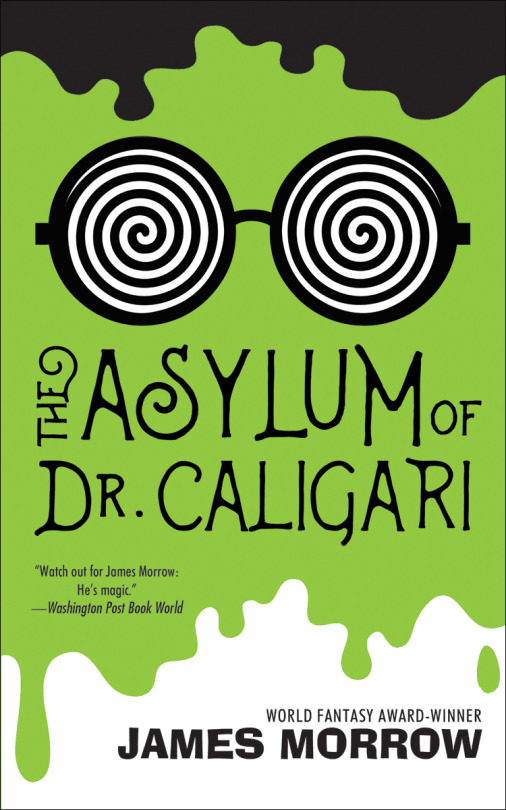With THE ASYLUM OF DR. CALIGARI, James Morrow spins a great yarn
Reviews keep rolling in for James Morrow’s THE ASYLUM OF DR. CALIGARI.

For SEE THE ELEPHANT, William Grabowski praises the novella.
Morrow’s new novella, THE ASYLUM OF DR. CALIGARI, is political satire well beyond the legendary 1920 German Expressionist film THE CABINET OF DR. CALIGARI. Flinging love-darts at Freud, surrealism, Nietzsche (brilliant madman, or just plain mad?), Picasso, and the intrinsic (or not) value of art, Morrow pulls off that most difficult “trick”: humor rooted in sadness, particularly the type churning beneath history like a black river.
Among the doctor/sorcerer’s covert weapons is a mural-sized painting akin to Picasso’s Guernica, which charges anyone who views it with murderous compulsions. Enter Francis Wyndham, artist, who teaches art therapy at Caligari’s Weizenstaat “clinic,” where patients apparently are urged to enter what can only be described as induced cognitive dissonance—a state worse than that which brought them there. But it’s World War I, and they all could die at any moment. As another great writer once wrote: Nothing is true. Everything is permitted.
It certainly is in THE ASYLUM OF DR. CALIGARI, whose entrance might come with a warning: Abandon sanity all ye who enter here—until you cheer up.
Joe Karpierz in MT VOID 05/26/17 (Vol. 35, No. 48) enjoys the book.
Morrow fills the book with a good number of scenes that must have been as fun to write as they were to read: Wyndham and his cohorts watching soldiers of various countries being marched in front of the painting and coming out ready to march to their death for their countries; a similar scene with Wyndham’s and Wessel’s painting, except with the opposite results; and in a bit of storytelling reminiscent of the scene of Dick Van Dyke’s character in Mary Poppins jumping into a painting to do a song and dance, Wyndham and Wessels jump into their painting–with characters there recognizing who Ilona is–to try to stop Caligari’s effort.
The key word in that paragraph is storytelling. Morrow spins a great yarn in this novella. The writing is excellent, the characters come to life on the page and make us care about them, and there is enough magic, psychology, art and romance to keep most readers engaged and interested. Indeed, Morrow injects a good variety of things to think about, and yet the novella doesn’t feel forced when it finally comes to an end–and make no mistake, there is a definite ending here. The ending itself is a bit melancholy; it’s almost as if Morrow is showing us that as with any fictional character, those who live in magical paintings can come to an end too. The ending didn’t leave me wanting for more, but it was a satisfying conclusion to the story and the characters therein.
We’re not looking at a great piece of literature here that will be remembered for decades to come, I think. But what we are talking about is a fun and whimsical story that will keep the reader eagerly turning the pages and being very happy with what they’ve read. A lot of times, that’s all readers really need anyway.

At DIABOLIQUE, Sheila M. Merritt reviews the work.
Despite all the sabotage and machinations, the tale is basically ruminations on philosophical topics. Author Morrow sees the impish humor that exists in political and aesthetic theorizing. He is a crafty wordsmith who likes to hone in on poseurs and pretensions.
THE ASYLUM OF DR. CALIGARI, published by Tachyon Publications, may mislead devotees of the film because of its title. That could be construed as a faux lure. Readers who are fond of wry esoteric musings will not be disappointed.
Andrew Wheeler of THE ANTICK MUSINGS OF G. B. H. HORNSWOGGLER, GENT. is excited about THE ASYLUM OF DR. CALIGARI.
A big bonus is when it’s a new book by a writer I’ve been reading and loving for decades, of course. Like today – with a new James Morrow short novel from Tachyon.
<snip>
This one is set in 1914, and, yes, it is a retelling of that classic German Expressionist film THE CABINET OF DR. CALIGARI, in prose form. But, in Morrow’s version, the diabolical doctor has created a painting that can brainwash anyone who sees it – and plans to charge governments to use it to turn their solders into perfect soldiers, with no sense of self-preservation. Our hero is a young American painter, and he sounds like a typical Morrow protagonist: noble enough to see something horrible wrong but possibly not strong enough to stop it.
Morrow has always been the great moral writer of the SF field, deeply concerned with the big questions of evil and hatred and death. DR. CALIGARI looks like no exception, and I hope you’ll be as happy to see it as I am.
For more info on THE ASYLUM OF DR. CALIGARI, visit the Tachyon page.
Cover by Elizabeth Story
